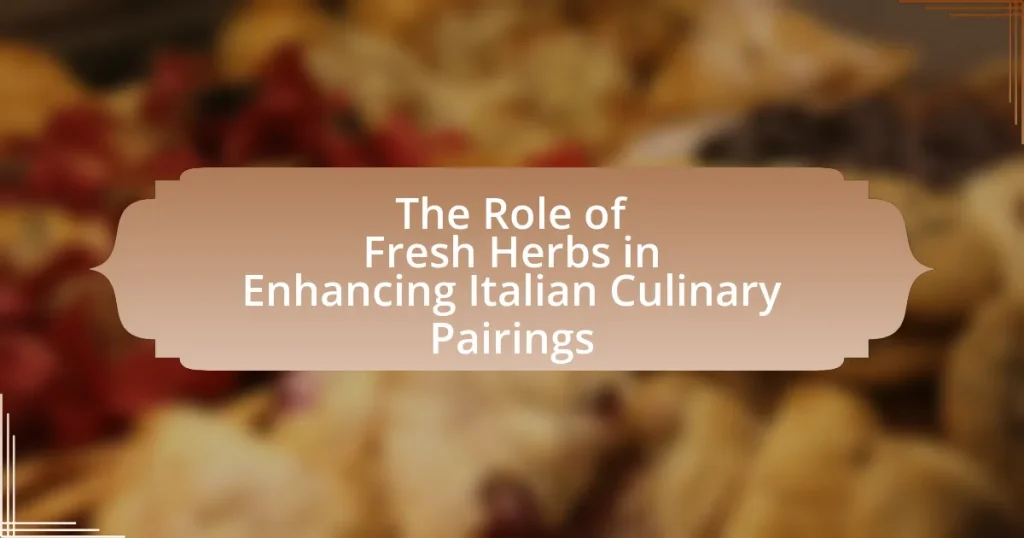Fresh herbs are essential in Italian cuisine, significantly enhancing the flavor, aroma, and presentation of dishes. Key herbs such as basil, oregano, parsley, rosemary, and thyme are integral to traditional recipes, providing freshness and complexity that elevate the dining experience. The article explores how fresh herbs improve the sensory qualities of food, their role in classic Italian dishes, and the best practices for their use, including storage and incorporation techniques. Additionally, it highlights the differences between fresh and dried herbs, emphasizing the importance of freshness in achieving authentic Italian flavors and culinary pairings.

What is the role of fresh herbs in Italian cuisine?
Fresh herbs play a crucial role in Italian cuisine by enhancing flavor, aroma, and presentation of dishes. They are integral to traditional recipes, providing freshness and complexity that elevate the overall dining experience. For instance, basil is essential in pesto and tomato sauces, while parsley is commonly used as a garnish and flavor enhancer in various dishes. The use of fresh herbs is rooted in Italy’s agricultural practices, where local herbs like oregano, rosemary, and thyme are abundant and contribute to the regional identity of Italian cooking. Studies show that the incorporation of fresh herbs can significantly improve the sensory qualities of food, making them a vital component in achieving authentic Italian flavors.
How do fresh herbs enhance the flavors of Italian dishes?
Fresh herbs enhance the flavors of Italian dishes by adding vibrant aromas and complex tastes that elevate the overall culinary experience. For instance, basil contributes a sweet, peppery flavor that complements tomatoes in sauces, while oregano provides a warm, earthy note that enriches meat dishes. Studies show that the volatile compounds in fresh herbs, such as essential oils, interact with other ingredients, creating a harmonious balance of flavors. This interaction is particularly evident in classic Italian recipes like pesto, where fresh basil, garlic, and pine nuts blend to create a rich, aromatic sauce that exemplifies the importance of herbs in Italian cuisine.
What specific herbs are commonly used in Italian cooking?
Basil, oregano, parsley, rosemary, and thyme are specific herbs commonly used in Italian cooking. Basil is a key ingredient in dishes like pesto and Caprese salad, while oregano is essential for sauces and pizza. Parsley adds freshness to various dishes, rosemary is often used for meats and roasted vegetables, and thyme complements sauces and stews. These herbs not only enhance flavor but also contribute to the traditional Italian culinary profile, reflecting the country’s agricultural practices and regional cuisines.
How do the flavors of fresh herbs complement traditional Italian ingredients?
Fresh herbs enhance traditional Italian ingredients by adding layers of flavor, brightness, and aromatic complexity. For instance, basil’s sweet and slightly peppery notes elevate the taste of tomatoes, a staple in Italian cuisine, creating a harmonious balance in dishes like Caprese salad and marinara sauce. Similarly, parsley’s fresh and slightly bitter profile complements rich ingredients such as olive oil and garlic, often found in pasta dishes. The use of herbs like oregano and thyme introduces earthy undertones that deepen the flavor of meats and sauces, aligning with the robust nature of Italian cooking. Studies have shown that the volatile compounds in fresh herbs can enhance the sensory experience of food, making dishes more appealing and flavorful.
Why are fresh herbs preferred over dried herbs in Italian culinary practices?
Fresh herbs are preferred over dried herbs in Italian culinary practices because they provide a more vibrant flavor and aroma, enhancing the overall taste of dishes. The freshness of herbs like basil, parsley, and oregano contributes essential oils that are often lost during the drying process, resulting in a more pronounced and complex flavor profile. Additionally, fresh herbs add a visual appeal and texture to dishes, which is important in Italian cuisine that emphasizes presentation. Studies have shown that fresh herbs can contain higher levels of antioxidants and nutrients compared to their dried counterparts, further supporting their use in health-conscious cooking.
What are the differences in flavor profiles between fresh and dried herbs?
Fresh herbs typically have a brighter, more vibrant flavor profile compared to dried herbs, which tend to have a more concentrated and sometimes muted taste. The essential oils in fresh herbs are more volatile, providing a fresh and aromatic quality that enhances dishes, particularly in Italian cuisine where herbs like basil and parsley are used. In contrast, the drying process reduces the moisture content and can intensify certain flavors, but it also diminishes the overall freshness and complexity. For example, dried oregano has a stronger, more pungent flavor than fresh oregano, which is often more subtle and sweet. This difference in flavor profiles is crucial in culinary applications, as fresh herbs are often added at the end of cooking to preserve their flavor, while dried herbs are typically used earlier to infuse their essence into the dish.
How does the freshness of herbs impact the overall dish quality?
The freshness of herbs significantly enhances the overall quality of a dish by providing vibrant flavors and aromas that elevate the culinary experience. Fresh herbs contain essential oils and compounds that contribute to their intense taste, which diminishes in dried or wilted herbs. For instance, a study published in the Journal of Food Science found that fresh basil retains higher levels of volatile compounds compared to dried basil, resulting in a more pronounced flavor profile in dishes like pesto or Caprese salad. This impact on flavor directly correlates with the overall satisfaction and perception of the dish, making freshness a critical factor in culinary pairings.

How do fresh herbs influence specific Italian culinary pairings?
Fresh herbs significantly enhance specific Italian culinary pairings by adding depth, aroma, and flavor complexity to dishes. For instance, basil complements tomatoes in Caprese salad, creating a balance of sweetness and acidity, while parsley brightens rich sauces like pesto, enhancing the overall taste profile. Additionally, rosemary pairs well with roasted meats, infusing them with a fragrant, earthy quality that elevates the dish. Studies show that the volatile compounds in fresh herbs can enhance the sensory experience of food, making them essential in Italian cuisine for achieving harmonious flavor combinations.
What are some classic Italian dishes that benefit from fresh herbs?
Classic Italian dishes that benefit from fresh herbs include Caprese salad, pesto, and risotto. Caprese salad, made with fresh mozzarella, tomatoes, and basil, relies on basil for its aromatic flavor. Pesto, a sauce originating from Genoa, is primarily made with fresh basil, garlic, pine nuts, and olive oil, showcasing the herb’s essential role. Risotto, particularly variations like risotto alla Milanese, often incorporates fresh herbs such as parsley or thyme to enhance its flavor profile. These dishes exemplify how fresh herbs elevate the taste and authenticity of Italian cuisine.
How do fresh herbs enhance the taste of pasta dishes?
Fresh herbs enhance the taste of pasta dishes by adding vibrant flavors and aromatic qualities that elevate the overall dish. For instance, basil contributes a sweet and slightly peppery taste, while parsley adds freshness and brightness. These herbs contain essential oils and compounds that release during cooking, intensifying the flavor profile of the pasta. Studies have shown that the use of fresh herbs can significantly improve the sensory attributes of food, making dishes more appealing and enjoyable.
In what ways do fresh herbs elevate the flavors of sauces and dressings?
Fresh herbs elevate the flavors of sauces and dressings by adding vibrant aromas, enhancing complexity, and providing fresh, bright notes. The essential oils in herbs like basil, parsley, and oregano contribute to a layered flavor profile, making sauces and dressings more aromatic and appealing. For instance, basil’s sweet and slightly peppery flavor complements tomato-based sauces, while parsley adds a fresh, grassy note that balances richness in dressings. Studies have shown that fresh herbs can increase the perception of freshness and enhance overall taste satisfaction, making them essential in Italian culinary pairings.
How can fresh herbs be paired with various Italian ingredients?
Fresh herbs can be paired with various Italian ingredients by complementing their flavors and enhancing the overall dish. For instance, basil pairs well with tomatoes and mozzarella in Caprese salad, while parsley enhances the flavor of seafood dishes like spaghetti alle vongole. Oregano is commonly used with meats and tomato sauces, providing a robust flavor that balances richness. Additionally, rosemary works effectively with roasted meats and potatoes, imparting a fragrant aroma. These pairings are rooted in traditional Italian cuisine, where the use of fresh herbs is essential for achieving authentic flavors.
What herbs work best with meats in Italian cuisine?
Rosemary, sage, and oregano are the herbs that work best with meats in Italian cuisine. Rosemary complements lamb and pork, enhancing their flavors with its aromatic profile. Sage pairs well with poultry and pork, providing a savory depth. Oregano is commonly used with beef and chicken, contributing a robust, earthy taste that is characteristic of Italian dishes. These herbs not only elevate the taste of the meats but also align with traditional Italian cooking practices, where fresh herbs are integral to flavor development.
Which herbs complement seafood dishes in Italian cooking?
Basil, parsley, oregano, and dill are herbs that complement seafood dishes in Italian cooking. Basil adds a fresh, aromatic flavor that pairs well with tomato-based seafood sauces. Parsley enhances the dish’s brightness and is often used as a garnish. Oregano provides a robust, earthy note that complements grilled or baked fish. Dill, while less traditional, offers a unique flavor that works well with shellfish. These herbs are commonly used in Italian recipes, showcasing their importance in enhancing the overall taste of seafood dishes.

What are the best practices for using fresh herbs in Italian cooking?
The best practices for using fresh herbs in Italian cooking include selecting high-quality, vibrant herbs, using them at the right stage of cooking, and pairing them appropriately with other ingredients. Fresh herbs like basil, parsley, and oregano should be added towards the end of cooking to preserve their flavor and aroma, as prolonged heat can diminish their potency. Additionally, herbs should be chopped or torn just before use to release essential oils, enhancing their flavor profile. Pairing herbs with complementary ingredients, such as basil with tomatoes or rosemary with meats, maximizes their impact in dishes. These practices are rooted in traditional Italian culinary techniques, which emphasize the freshness and quality of ingredients to create authentic flavors.
How should fresh herbs be stored to maintain their flavor?
Fresh herbs should be stored in a way that minimizes moisture and maximizes freshness to maintain their flavor. For most herbs, wrapping them in a damp paper towel and placing them in a plastic bag in the refrigerator is effective, as this method helps retain moisture without causing rot. Alternatively, herbs like basil can be stored upright in a glass of water at room temperature, similar to a bouquet, which allows them to stay fresh longer. Research indicates that proper storage techniques can extend the shelf life of fresh herbs by several days, preserving their essential oils and flavors crucial for culinary applications.
What techniques can be used to maximize the flavor of fresh herbs in dishes?
To maximize the flavor of fresh herbs in dishes, techniques such as bruising, chopping, and adding herbs at the right cooking stage are effective. Bruising herbs releases essential oils, enhancing their aroma and taste, while chopping increases the surface area for flavor release. Adding herbs towards the end of cooking preserves their fresh flavor and vibrant color, as prolonged heat can diminish their potency. Research indicates that the volatile compounds in herbs, which contribute to their flavor, are most potent when fresh and minimally processed, supporting the effectiveness of these techniques.
How can fresh herbs be incorporated into recipes for optimal taste?
Fresh herbs can be incorporated into recipes for optimal taste by adding them at different stages of cooking to enhance flavor profiles. For instance, adding delicate herbs like basil and parsley towards the end of cooking preserves their fresh aroma and vibrant taste, while sturdier herbs like rosemary and thyme can be added earlier to infuse their flavors into the dish. Research indicates that the volatile oils in fresh herbs contribute significantly to the overall flavor, making their timing of addition crucial for achieving the desired taste.
What tips can home cooks follow to effectively use fresh herbs in Italian dishes?
Home cooks can effectively use fresh herbs in Italian dishes by incorporating them at the right stages of cooking. For instance, adding robust herbs like rosemary and thyme early in the cooking process allows their flavors to infuse into the dish, while delicate herbs like basil and parsley should be added towards the end to preserve their fresh taste and aroma. Additionally, using a variety of herbs can enhance the complexity of flavors; for example, combining basil with oregano can create a more rounded flavor profile in sauces. Research indicates that fresh herbs not only enhance flavor but also provide health benefits, such as antioxidants and anti-inflammatory properties, making them a valuable addition to Italian cuisine.
How can one experiment with different herb combinations in Italian recipes?
To experiment with different herb combinations in Italian recipes, one can start by selecting a base herb commonly used in Italian cuisine, such as basil, oregano, or parsley, and then gradually introduce complementary herbs like thyme, rosemary, or sage. This method allows for a systematic exploration of flavor profiles, as each herb contributes distinct aromatic qualities that can enhance the overall dish.
For instance, combining basil with oregano can create a classic Italian flavor, while adding rosemary can introduce a more robust and earthy note. Additionally, tasting the dish at various stages of the cooking process can help gauge the impact of each herb combination, allowing for adjustments based on personal preference.
Research indicates that the balance of flavors in culinary applications is crucial for enhancing the dining experience, as supported by studies on flavor pairing principles in gastronomy. By applying these principles, one can effectively experiment with herb combinations to discover new and exciting flavors in Italian recipes.
What common mistakes should be avoided when using fresh herbs in cooking?
Common mistakes to avoid when using fresh herbs in cooking include adding them too early in the cooking process, which can lead to loss of flavor and aroma. Fresh herbs are delicate and should typically be added towards the end of cooking to preserve their vibrant taste. Additionally, using dried herbs instead of fresh ones can diminish the dish’s overall flavor profile, as fresh herbs provide a more intense and aromatic experience. Over-chopping fresh herbs can also release too many essential oils, resulting in a bitter taste. Lastly, not properly washing fresh herbs can introduce dirt and pesticides into the dish, compromising both flavor and safety.










